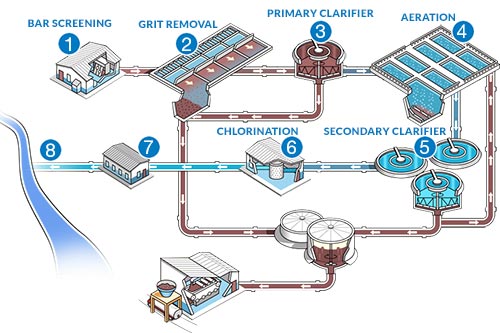Some Known Factual Statements About Residential Water Treatment System
Table of ContentsThe Main Principles Of Residential Water Treatment System Residential Water Treatment System for BeginnersSome Ideas on Residential Water Treatment System You Should KnowThe Best Guide To Residential Water Treatment System

on the various other hand, comes from production, industrial and also business activities brought and has a completely various structure than sewage water. Exactly how does it function? The very first step in this water therapy plant is that the wastewater drains pipes to the plant with the help of gravity through the major drain system.
In this phase, the water moves through the gravel chamber to get rid of any grit. The water after that moves to the bar screens which eliminate big items.
This is then eliminated from the storage tank as well as disposed of at the dump. Following comes the sedimentation stage, also referred to as the primary therapy. In this stage, the water flows to the main settling storage tanks, likewise called pre-settling basins. These containers have hoppers which are situated in the base of the tank where water flows with.
What Does Residential Water Treatment System Do?
These working out tanks make it possible for the sludge to clear up and afterwards moves to food digestion storage tanks. In the digestion tanks, the sludge is warmed as well as combined. One more important point that occurs below is the production of biogas, which the wastewater treatment plants can recycle, in the production of electrical or thermal power which is one more massive benefit to the environment.

The last action in wastewater therapy is assessment. This examination involves checking the contamination level of the water treated and making certain it abides by the highest criteria in order to be released or reused for domestic or industrial purposes. residential water treatment system. Applications: The majority of petroleum refineries or petrochemical along with chemical sectors create a large quantity of wastewater and also need on-site wastewater treatment plants.
The wastewater here moves through displays and also right into negotiation containers that can obtain particles in large amounts. It serves as a pre-treatment as specified over as it takes place prior to three even more hostile phases- main, second as well as tertiary treatment. Main Treatment During this stage, the wastewater moves into the clarifiers.
4 Simple Techniques For Residential Water Treatment System
It is the style of these containers that cause working out, that is, the natural solid matter gathers at the bottom of the container while the lighter matter floats to the top ending up being simpler for removal. The organic issue that works out near click for info the bottom is referred to as a main sludge covering.
Additional Treatment This therapy phase includes cardio aeration. Oygenation containers include aerators, these have a system of pipes or tubes connected to them. They are made of ceramic or rubber membrane layers that have small openings in them for air to go through. When this air moves with the aerators, the small openings existing, transform them into bubbles as well as they get mixed with the water column.
This RAS goes back right into the primary information tank and also the bacteria in it helps in damaging down any raw material in the sewage. When RAS has actually entirely undergone both the main and additional clarification containers continuously, i. e a number of times, it is become waste-activated sludge (WAS). The WAS after that does not go back to the primary clarification container but instead moves to the covered containers, additionally called aerobic sludge digesters.
The staying sludge relocations to the dewatering facility that includes dewatering storage tanks where the plant utilizes belt presses to squeeze any continuing to be water out of the sludge. Tertiary Therapy Tertiary therapy follows the process of both primary and second processes but also in addition involves mechanical and photochemical procedures.
Excitement About Residential Water Treatment System
Right here the emphasis is given to physical strategies such as screening, sedimentation, filtration, clarification etc. The goal of this is to eliminate as much strong physical matters as feasible before sending out the effluent for additional treatment. This stage includes the removal of solid waste as well as organic issue. Below chemicals are included to damage down any type of strong as well as chemical waste.
There are two kinds of resins- one is an anion one while the other is a cation one. These previous resins launch hydroxyl ions which are negatively billed while the cation resins launch hydrogen ions that are favorably billed. The cation-exchange resins result in conditioning of water, the anion-exchange lead to the elimination of nitrate from wastewater as well as the combination of both the anion as well as cation exchange gets rid of basically every ionic contaminant present in the feed water with a process called deionization (residential water treatment system).
Applications: Demineralization leads to the full elimination of minerals from the water and also is generally made use of in markets that need water with high levels of pureness, for instance- make-up or feed water in high-pressure central heating boilers, the food as well as drink sector, and procedure streams used in the manufacturing of electronics. look at this site They are additionally utilized in sectors for the generation of vapor, power and also air conditioning.
Reverse Osmosis (RO) Water Treatment The principle of reverse osmosis (RO) operates on the filtration technique that causes the elimination of a multitude of impurities and their website contaminations from wastewater by using pressure to it when it gets on one side of a membrane layer. How does it work? This water therapy plant functions by utilizing a high-pressure pump that raises the stress on the salt side of the RO as well as requires the water throughout the semipermeable RO membrane (which permits some atoms and particles to pass yet not others), leaving virtually 95%-99% of liquified salts in the deny stream.